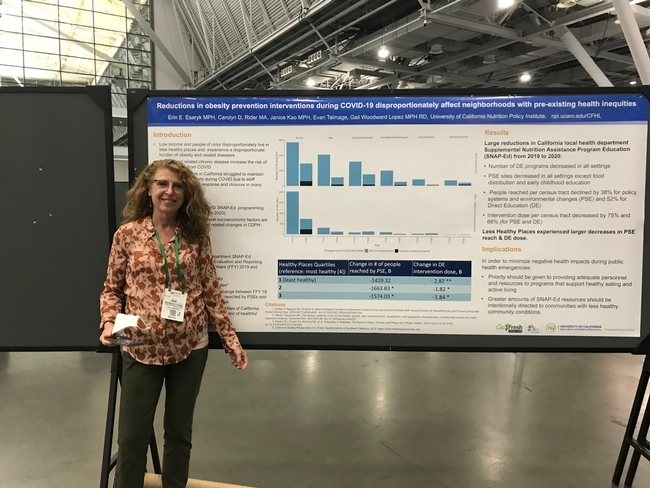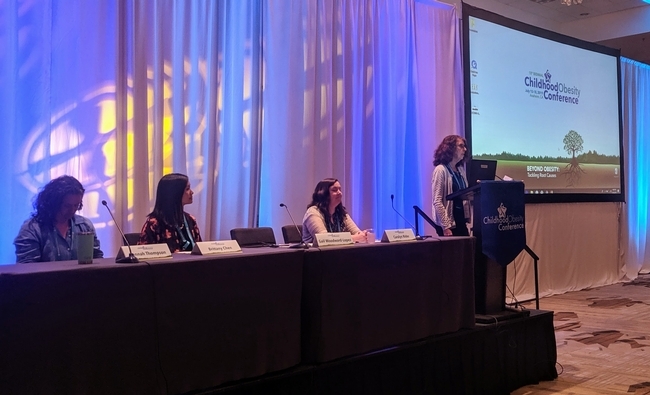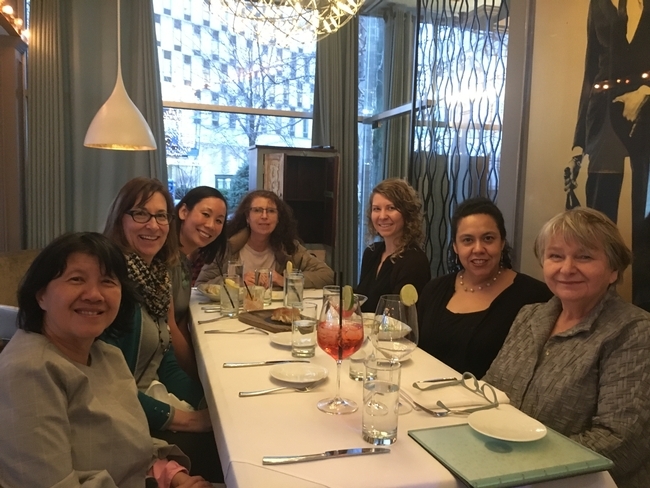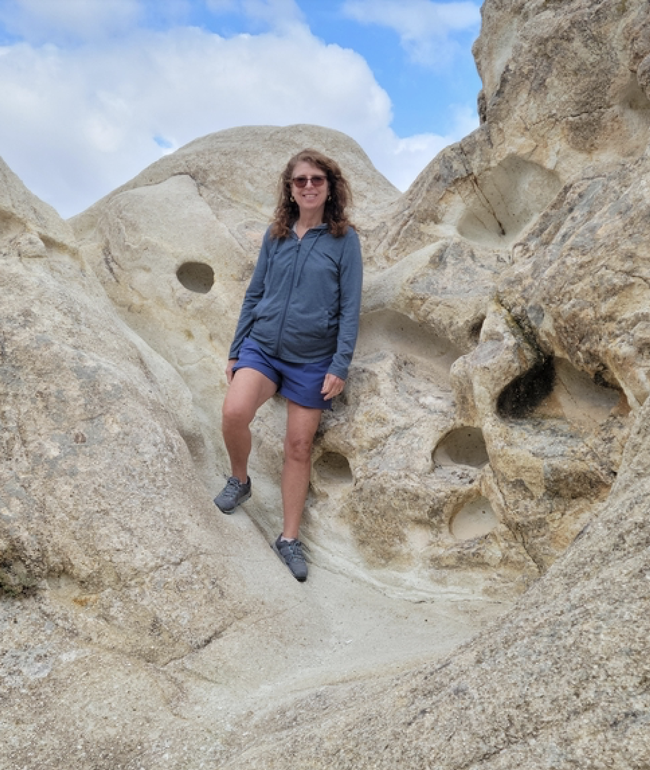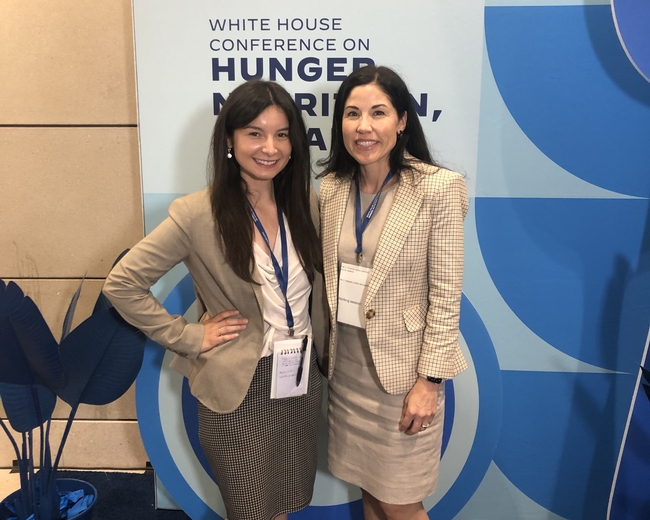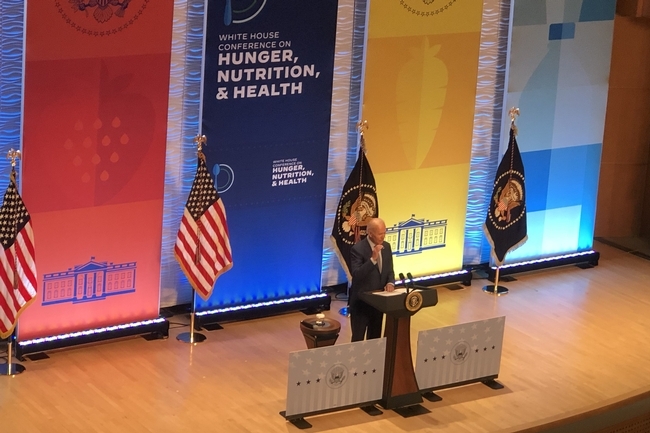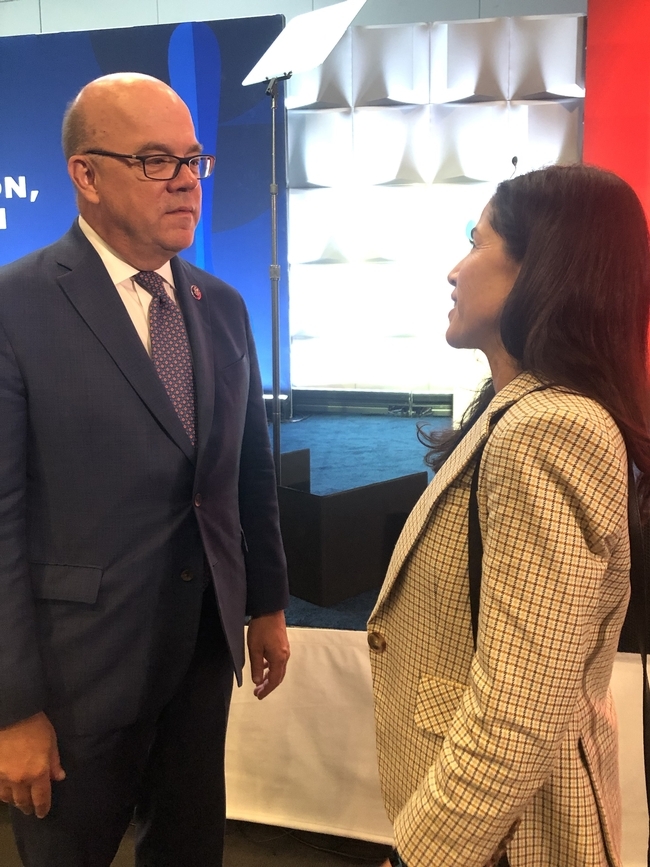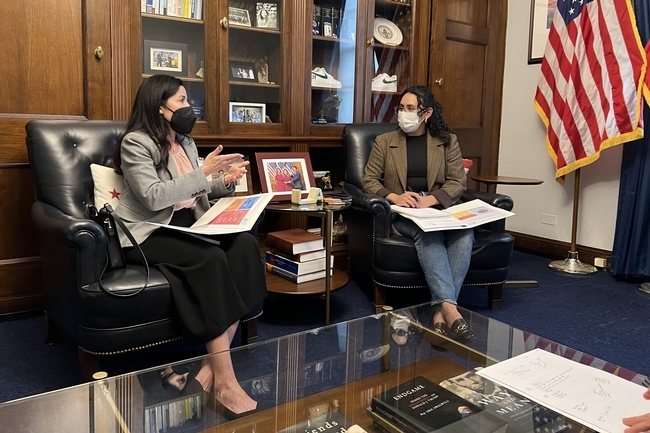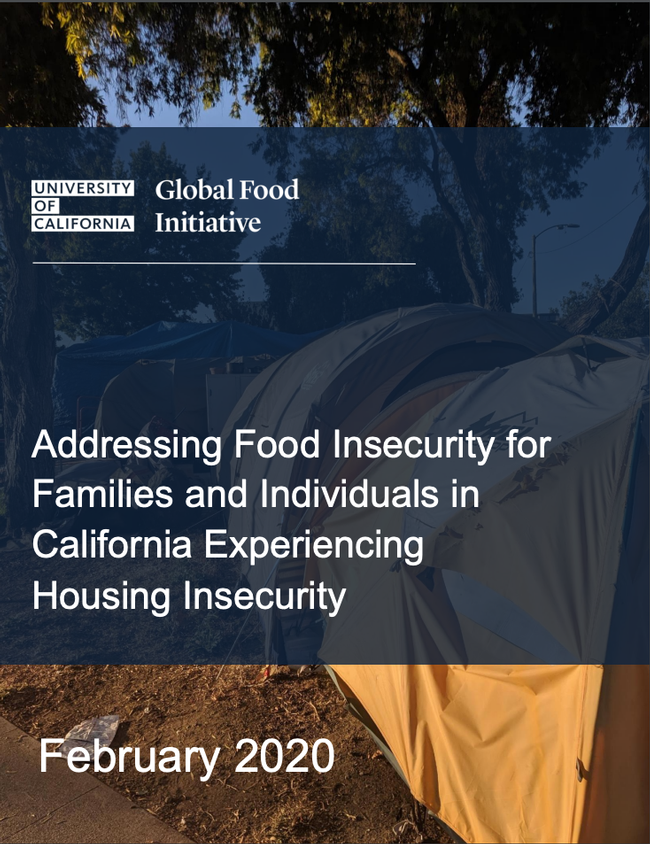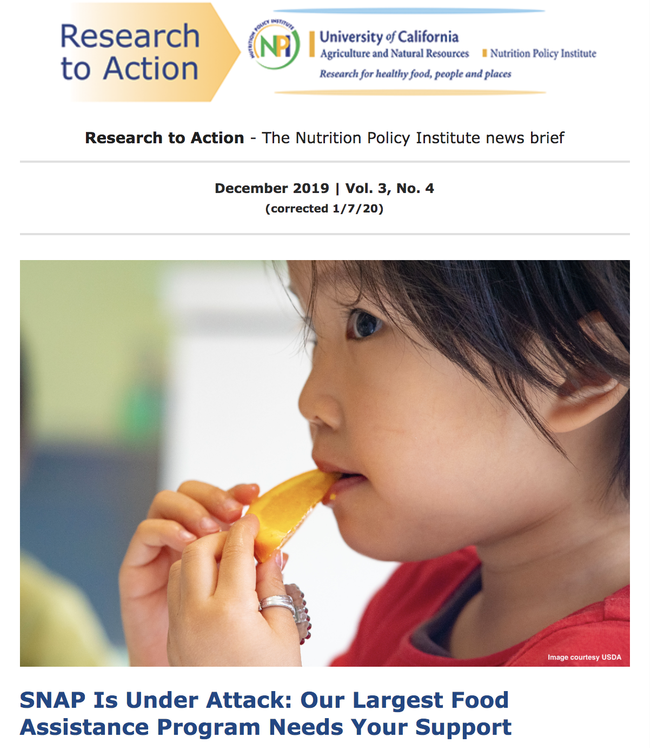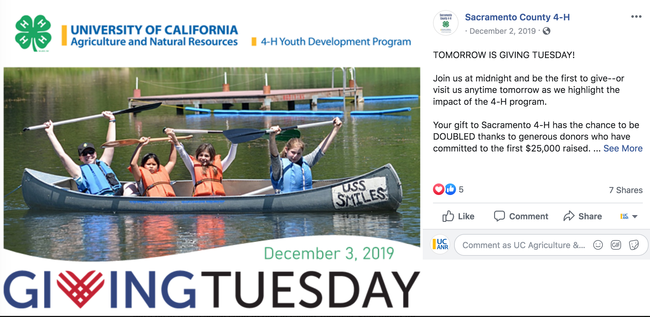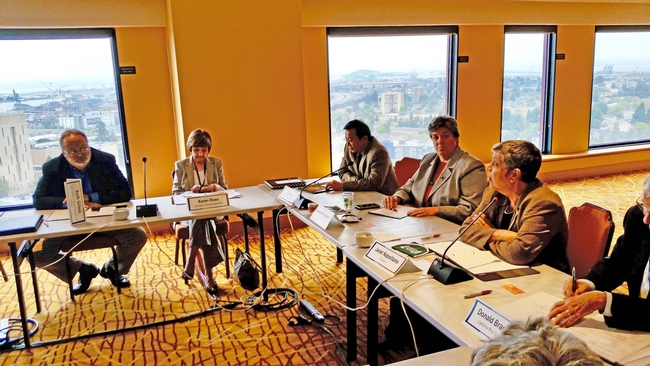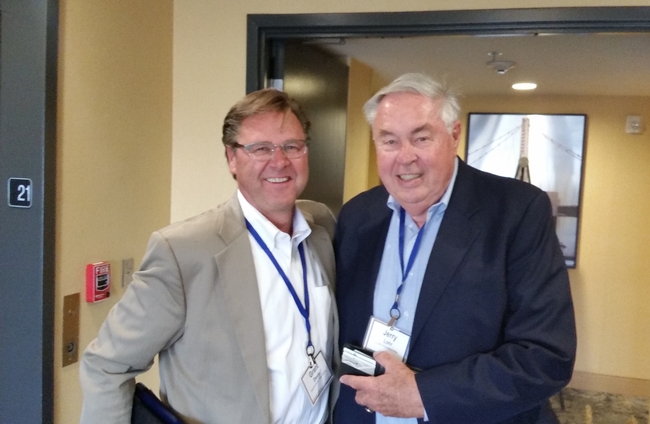Posts Tagged: Nutrition Policy Institute
Woodward-Lopez retires after 23 years of leadership in advancing nutrition
Young people across California and the U.S. enjoy healthier, more nutritious food options at school, thanks to the contributions of Gail Woodward-Lopez, who retired on July 1 as the associate director of research at the Nutrition Policy Institute, a part of University of California Agriculture and Natural Resources.
Woodward-Lopez officially joined UC ANR in 2015, when she and other researchers at the Atkins Center for Weight and Health at UC Berkeley merged with NPI. But her association with UC ANR goes back much further, as her work at CWH was always directed by UC Cooperative Extension academics – including the research that paved the way for California's “junk food ban” in schools.
Two groundbreaking bills, signed in 2005, set nutrition standards in California for “competitive foods”– the items sold in vending machines and from food service a la carte (as opposed to federally subsidized school meals). That legislation – which inspired similar policy changes across the country – was informed by the work of Woodward-Lopez and her colleagues, who had looked at the financial impact of establishing those standards.
“Our study was so pivotal that I literally had people calling me from the floor of the Senate or the Assembly when they were debating that legislation,” recalled Woodward-Lopez.
Changing perceptions of population weight gain
Originally intending to pursue a career in neurobiology, Woodward-Lopez found that lab work didn't suit her temperament. Seeking to work more directly on social issues, she embarked on a public health path, with an emphasis on nutritional aspects that incorporated her interest in biological sciences.
Woodward-Lopez's early work focused on a challenge that was just beginning to catch the attention of researchers: the rapid rise in the Body Mass Index (BMI) among the U.S. population. In tracing the causes of this epidemic, she and her colleagues shifted academic and public attention toward the host of environmental factors that contribute to weight gain – instead of focusing exclusively on an individual's choice to eat healthy and be physically active.
Woodward-Lopez, who helped set the identity and agenda of the Center for Weight and Health when it was founded in 2000, moved policy and practice beyond educational approaches and public awareness campaigns. As she noted: “No one thinks sugar-sweetened beverages are good for you.”
“Education alone is not going to work if people do not have access to the healthy foods and opportunities for physical activity, if they're not safe in their neighborhoods, or if they can't afford the healthy options,” she explained.
Given her seminal role in the field, Kaiser Permanente sought out Woodward-Lopez as a “thought partner” on the organization's community-based obesity prevention programs and school health work.
“Gail brought deep rigor and expertise, of course, but also a super-practical, community-focused perspective to our work,” said Loel Solomon, professor of health systems science at the Kaiser Permanente Bernard J. Tyson School of Medicine. “Her integrity and values around health equity were evident in everything we did together, and our communities are so much the better for it.”
Elevating and enhancing CalFresh Healthy Living
At the Nutrition Policy Institute, the focus of Woodward-Lopez's work has been refining the evaluation and delivery of SNAP-Ed, the educational component of the Supplemental Nutrition Assistance Program (commonly referred to as “food stamps”). Known in California as CalFresh Healthy Living, SNAP-Ed represents the largest single source of ongoing funding for nutrition and physical activity promotion in the state.
“The program can really impact millions of people,” Woodward-Lopez said. “For county health departments, this is one of their main sources of funding and provides the backbone for everything else they do in nutrition and physical activity.”
But given the unevenness and variety of interventions implemented by local health departments, determining the efficacy of those efforts is a daunting task. Woodward-Lopez and her NPI colleagues have been instrumental in devising creative approaches that help pinpoint the most effective public health measures.
For example, researchers found that combining school policy changes with increased opportunities for physical activity was the best strategy to encourage student fitness. They discovered that health departments diverting resources away from nutrition programs during the COVID-19 pandemic disproportionately affected communities of color. And they also continue to emphasize that interventions need to be tailored to the specific cultural and political conditions within a community.
“I think in all of the work we do, we try to come up with those practical applications – what does this mean for communities? How can we do this differently? How are our findings actionable?” Woodward-Lopez said.
Her contributions toward the evaluation of California Department of Public Health SNAP-Ed have impressed and inspired Lauren MacKenzie Whetstone, chief of CDPH's Research, Evaluation and Strategic Alignment Section, Nutrition Education and Obesity Prevention Branch.
“Gail and her team have elevated the quality of our evaluation work and the evaluation support that we provide to local health department grantees,” said MacKenzie Whetstone, who has known Woodward-Lopez for nearly a decade. “Gail contributed substantially to statewide SNAP-Ed evaluation as well, again working collaboratively to ensure high quality evaluation. Our work is all the stronger due to Gail's dedication to excellent SNAP-Ed evaluation.”
To the benefit of the field and community health, Woodward-Lopez plans to remain engaged in her life's work. While she looks forward to spending more time with loved ones, traveling and pursuing her interests in art and music, she will remain a guiding voice for advancing public health.
“I'd really like to get more involved in policy through advocacy and through doing things like writing letters to the editor or social media commentary,” she said. “I already have some ideas for some editorials I want to write.”
NPI work underpins historic White House conference on hunger, nutrition, health
At the first White House Conference on Hunger, Nutrition and Health convened since 1969, President Biden announced on Sept. 28 a national strategy “to end hunger in America and increase healthy eating and physical activity by 2030 so fewer Americans experience diet-related diseases.” Much of the foundational research undergirding the strategy has been informed in part by the Nutrition Policy Institute, a program of UC Agriculture and Natural Resources.
“Science is the work of many – and no one study answers all the questions – but we have a tremendous body of work that has contributed to this conference, building from all the programs and changes that were made from the last conference,” said NPI director Lorrene Ritchie.
The original Nixon-era conference produced about 1,800 recommendations – and 1,600 were eventually implemented in the subsequent years, according to Stacy Dean, U.S. Department of Agriculture Deputy Under Secretary for Food, Nutrition and Consumer Services.
A litany of far-reaching programs grew from or were propelled by the 1969 conference: the School Breakfast Program, WIC (the Special Supplemental Nutrition Program for Women, Infants and Children), SNAP (the Supplemental Nutrition Assistance Program)-Ed and CalFresh Healthy Living UC, the Expanded Food and Nutrition Education Program and more.
This history illustrates the potential for sweeping change from this 2022 conference – which gathered about 500 experts and advocates (with 1,000 more participating online) – and from the national strategy that represents the Biden-Harris administration's “playbook.”
“Does that document have everything in it that we would like? No – but, oh my goodness, if we could accomplish all the things that they've laid out, what a transformational impact it would have,” said Ritchie, adding that she was thrilled that the highest levels of government are prioritizing hunger and nutrition-related chronic disease.
Including beverages in the conversation
“NPI's recommendations were built on lots of work by many water researchers and advocates over the years; they're based on many years of thinking by many people,” Hecht said.
Christina and Ken Hecht, NPI policy director, also submitted recommendations as part of the Sugar-Sweetened Beverage Reduction Workgroup, which brings together experts from national, state and local organizations. Several of their key proposals, such as targeting the marketing of sugary drinks and clarifying front-of-package nutrition labels, appear as recommended steps in the national strategy document.
Other nutrition policy changes compiled by Christina Hecht – like updating the Federal Food Service Guidelines used on federal properties and in federal programs – are also reflected in the national strategy, albeit without specifically mentioning sugary drinks. Nonetheless, Hecht believes doors have been opened for future discussions that could incorporate and promote healthy beverages.
“What those doors require are continuing to develop the evidence base, continuing to translate and share the evidence base, and continuing the advocacy to bring that evidence base to the attention of decision makers,” she said.
University of California setting an example
Suzanna Martinez, an NPI-affiliated researcher who attended the White House conference, said she hopes the convening generates momentum for two bills before Congress that would help alleviate food insecurity in higher education: one that provides funding for campuses to address students' basic needs, and another that reduces barriers to SNAP (Supplemental Nutrition Assistance Program, formerly known as food stamps). The national strategy document explicitly acknowledges that “SNAP's college student eligibility restrictions are out of date given the current population who seek higher education credentials.”
Martinez, an associate professor in the Department of Epidemiology and Biostatistics at University of California San Francisco, was invited to the conference because she's part of a group driving the UC's effort to halve the number of students facing food insecurity across the system by 2030. That commitment, and UC Berkeley's work on basic needs, were highlighted by Second Gentleman Douglas Emhoff during the closing plenary session.
“The work that we're doing here in California tends to set the stage for what happens in other states,” said Martinez, who also cited California's pioneering effort to provide meals for all public school students.
NPI's ongoing work evaluating universal school meals in California and other states is just one example of how its academics and staff are refining innovative programs so they can be adopted more effectively and broadly (perhaps nationally). In fact, the White House identified “healthy school meals for all” as the top strategy for improving food access and affordability, and Ritchie applauds the administration's consistent emphasis on early interventions for healthier outcomes.
“The earlier you can create healthy habits – meaning in utero all the way through childhood – the more likely you are going to have adults who don't end up with nutrition-related chronic diseases,” she explained. “The last thing you want to do is to wait until people are really sick before they start to change their habits.”
Another overarching theme that excites Ritchie is the national strategy's “whole of government” approach to addressing a host of nutrition and hunger issues. One example is how the strategy calls for agencies not traditionally associated with food to contribute to reducing waste, such as the Department of the Treasury clarifying tax benefits for businesses that donate food.
“Throughout the document, over and over again, there are countless examples of creating synergies across government agencies and with local and state governments that can help move the needle,” Ritchie said. “It's just this kind of bold call to action that we really need.”
NPI study identifies efforts to address both food and housing insecurity in California
Californians are struggling to afford adequate housing and food, yet little is known about the intersection of individuals and families experiencing both housing and food insecurity. The Nutrition Policy Institute (NPI)'s 2018/2019 University of California (UC) Global Food Initiative fellow, Melanie Colvin, MPH, identified efforts to address both housing and food insecurity in California.
Her findings are detailed in the report, “Addressing food insecurity for families and individuals in California experiencing housing insecurity,” which provides definitions and prevalence rates for food insecurity and housing insecurity. In the report, Colvin summarizes assessment tools available for researches to measure food insecurity and housing insecurity. The report includes case studies of eight California organizations working to improve access to basic needs services for adults and families who struggle to afford the high cost of living in California.
With input from Danielle Lee, NPI policy analyst; Lorrene Ritchie, NPI director and UC Cooperative Extension specialist; Ken Hecht, NPI director of policy; Rachel Surls, UCCE sustainable food systems advisor in Los Angeles; and Tia Shimada, California Food Policy Advocates director of programs, Colvin provides policy, program and research and evaluation recommendations to support improved food security for those experiencing housing insecurity.
The authors also recommend ways UC ANR can engage with communities and organizations to improve the delivery of basic needs services for Californians.
Read the full report at https://www.ucop.edu/global-food-initiative/_files/gfi-npi-report-final-2020-02-13.pdf.
UC ANR fundraising stars prove there really is ‘FUN’ in fundraising
But it doesn't have to! UC ANR's Development Services team is here to partner with you. Whether you have a project that needs funding, need advice on a donor, or want to participate in a giving day campaign, our team is here to share best practices, provide tools and work with you to be successful.
The Development Services team wants to recognize the success of several recent partnerships — programs and individuals who see the potential impact of donor dollars in supporting UC ANR's important work.
Danielle Lee at Nutrition Policy Institute deserves a shout out for her new Research to Action newsletter format. It hits many of the highpoints that we look for because it makes supporters feel really good about the work NPI is doing, and it has a clear call to action, providing readers the opportunity to donate. It is not a solicitation, but it makes it easy for someone to take that step if they choose.
Giving Tuesday All Stars
The 2019 Giving Tuesday campaign was another opportunity to “lean in” to fundraising; we'd like to recognize just a few of the #GT All Stars:
Best 1st Time Performer: Sustainable Ag Research & Education Program
Best Use of Personal Network: Ricky Satomi, Forest Ed. & Outreach
Best Use of Campaign Materials: UC Master Gardeners of Los Angeles
Get On Board Award: Master Food Preservers, San Bernardino
Insomniac Award (most gifts after midnight): 4-H, Glenn County
Outstanding Photo: 4-H, Sacramento County
Team Spirit Award (matched her staff giving): Lynn Schmitt-McQuitty
In addition to these All Stars, we want to thank the Statewide UC Master Gardeners and 4-H teams for being “Perfect Partners” in working to promote Giving Tuesday across the state. And we recognize the President's Advisory Commission, senior leadership and the 4-H Foundation Board for being “Match Makers” and giving $40,000 in incentive funds to motivate and double donor dollars.
Yes, fundraising takes effort. But know we are here to help. We're grateful for your partnership, but the ultimate reward comes when we engage donors to support the work we do to improve the lives of all Californians.
PAC discusses strategic plan and urban agriculture
Downtown Oakland was the site of the biannual UC President's Advisory Commission on Agriculture and Natural Resources (PAC) meeting on Aug. 9, which included a Q&A session with President Napolitano, program presentations from UC Cooperative Extension county directors Rob Bennaton and Igor Lacan, and updates from deans Helene Dillard (UC Davis), Keith Gilless (UC Berkeley) and Kathryn Uhrich (UC Riverside), as well as Executive Associate Dean John Pascoe (filling in for Dean Michael Lairmore, UC Davis School of Veterinary Medicine).
In her opening remarks, UC ANR Vice President Glenda Humiston introduced Mark Bell, the division's new vice provost for statewide programs and strategic initiatives. Bell spoke about the strength of the UC system, the diversity of programs offered by UC ANR statewide, and his plans to leverage the strong volunteer and staff base of programs like UC Master Gardeners and 4-H.
Humiston also offered updates on the division's strategic plan and the significant progress made in implementing its key goals. Associate Vice President Tu Tran then gave a presentation on the division's financial situation, which he titled “A Fiscal Plan for Success.” Tran addressed UC ANR's place in the state budget and its revenue projections through FY 2021-22, which includes significant growth in major gifts and fundraising.
Bennaton and Lacan both gave spirited and enthusiastic presentations that were received well. Bennaton, who serves as county director for Alameda and Contra Costa counties as well as UCCE urban agriculture advisor for the Bay Area, discussed the benefits of urban agriculture and the assortment of activities going on in community development, habitat restoration and youth programming.
Lacan, also a UCCE environmental horticulture advisor for the Bay Area and co-director in San Mateo and San Francisco counties, talked about the diverse and richly rewarding work he spearheads in urban forestry. His work currently focuses on sustainable management of urban trees and urban water.
During a Q&A period, the president engaged PAC members on various issues such as potential public-private partnerships that could involve UC ANR, targeted approaches to advocacy and deferred maintenance needs for UC writ large but also for UC ANR and its research and extension centers system, specifically.
The deans gave updates on research and activities occurring at their respective colleges and school.
The next PAC meeting is scheduled for December, also in Oakland.

